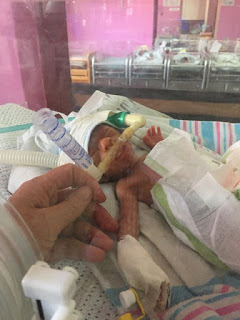Did you know that 1 in 10 babies in the world are born prematurely?
Or that being born prematurely is either the #1 or the #2 (sources vary) cause of death for children in the world?

Or that like all child survival, preterm infant survival is largely a matter of justice, of resources, of circumstances no child can choose about where they are born and to whom?
Or that there is a correlation between being born in a country at war and dying from prematurity?
In Kenya, neonatal causes of mortality are the top killer of children, and prematurity tops that list (the other two big issues are neonatal encephalopathy, aka birth asphyxia, caused by unattended issues during labor; and neonatal sepsis, aka infections caused by issues of hygiene, immunity, access to care, availability of antibiotics).
(Note that if you make it through the first 5 years, then death rates drop, but the top cause changes from Neonatal diseases to HIV/AIDS.)
Caring for preterm infants is a large part of my life, and has been over the 30 years that I have been a physician. Managing mothers and extending their gestation as long as possible is a large part of Scott's life. If anyone embodies the "least of these" then it would be a preterm infant. Care for the most vulnerable is a measure of a society's embrace of Gospel values. When we invest in these tiny fragile lives, we are all participating in Jesus' call to let the little children come, to give Jesus a drink and some warmth. Literally.
The good news is that many of the interventions that enable survival are within our reach. First, empowerment and education of girls, so that they become mothers when they are ready and have the capacity to make good decisions and seek care. Second, reach and excellence in antenatal care. In Kenya, pre-ecclampsia, a maternal disorder characterized by high blood pressure, multi-organ damage, and preterm delivery, requires solid consistent monitoring and options for high level care. We suspect that much of the quality improvement in Naivasha in recent years is due to better management of this issue. Third, safe deliveries. Fourth, neonatal care including warmth, oxygen by CPAP (pressure), managed tube feeds, IV fluids, antibiotics. Some of the solutions are fairly low-tech, like "kangaroo care" where a mother keeps her infant warm by wrapping skin to skin. Or "bubble CPAP" which is improvisable with tubes and bottles and water. A lot of it is just plugging through each day paying attention to the details. I always tell my trainees, no preem raises his hand and says, "doctor, my tummy hurts" or "doctor, I feel feverish". We have to pay attention and figure it out.
 Most of the above will NOT be achieved by neonatologists. It will be achieved by parents, teachers, school administrators, nurses, more nurses, nurse-midwives, MORE NURSE-MIDWIVES, and did I say nurses? More NURSES? We currently average 2 nurses per day shift, and often 1 at night, with student trainees at times to help, covering over 50 sick neonates in our Newborn Unit. Yet much of the difference between survival and death for preems is determined by nursing care. It's a lot of work, a high calling. But also very tangibly rewarding. Yes, the NBU is hot, and crowded. There are always 2-3 babies per incubator and sometimes 4. The cots under the phototherapy blue lights are piled with 2 and sometimes 3 babies in each one. The moms sit shoulder to shoulder expressing their milk. There are IV bottles in crazy clusters on poles. You have to pull out a calculator on your phone, a lot. It takes hours just to review 50+ sick babies each day.
Most of the above will NOT be achieved by neonatologists. It will be achieved by parents, teachers, school administrators, nurses, more nurses, nurse-midwives, MORE NURSE-MIDWIVES, and did I say nurses? More NURSES? We currently average 2 nurses per day shift, and often 1 at night, with student trainees at times to help, covering over 50 sick neonates in our Newborn Unit. Yet much of the difference between survival and death for preems is determined by nursing care. It's a lot of work, a high calling. But also very tangibly rewarding. Yes, the NBU is hot, and crowded. There are always 2-3 babies per incubator and sometimes 4. The cots under the phototherapy blue lights are piled with 2 and sometimes 3 babies in each one. The moms sit shoulder to shoulder expressing their milk. There are IV bottles in crazy clusters on poles. You have to pull out a calculator on your phone, a lot. It takes hours just to review 50+ sick babies each day.
But as we celebrate World Preemie Day, here's a shout out to the moms, the nurses, and the NBU team pictured above of students and interns yesterday at the end of rounds. Never give up, small lives depend upon it.


















No comments:
Post a Comment